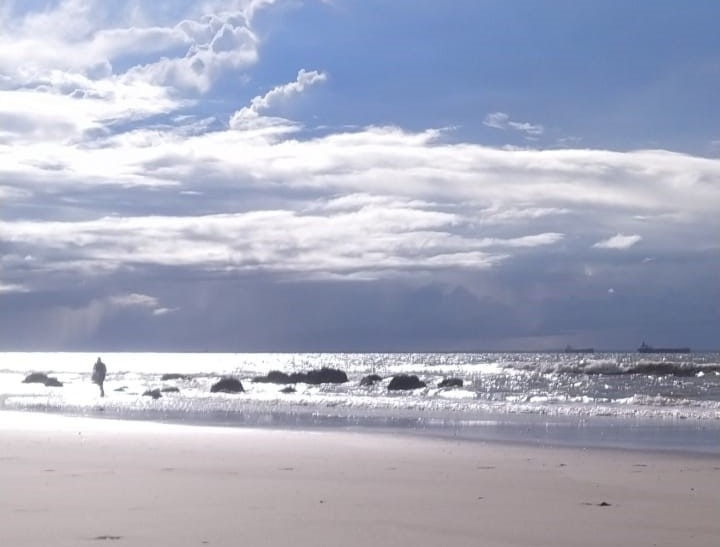Scientific research on seaweed is a great ally of the mariculture industry, which has been growing exponentially in recent years, especially red seaweed.

Agar-agar is a gelling powder that has been growing in popularity as a vegan alternative to gelatin, but has been used in microbiology as bacterial growing substrate for decades. It is a polysaccharide analogous to pectin (from fruit peels) exclusive to a specific group of red marine algae, the agarophytes. Unlike gelatin, which is made up of amino acids, this phycocolloid is a galactose polymer (the same one found in milk) with unique chemical properties, which gives it diverse therapeutic and biotechnological applications 1,2. It is an excellent source of fiber for human consumption and forms a kind of jelly that is more consistent than gelatin at room temperature. Few species of agarophytes accumulate enough agar for economic exploitation, but many initiatives of “marine agriculture”, or mariculture, are breeding strains with higher agar yield, what may foster a billion-dollar industry 3. Brazil has developed some studies in this field, including in the Northeast, where its biomass is abundantly found in intertidal regions 4.
"Red algae are indicators of water quality and can shelter several other marine species, in addition to being a good source of energy for mammals, fish, molluscs and crustaceans"
On the coast of São Luís, in Maranhão, at least 11 agarophyte species are found attached to stones and sand in tide pools 5,6. However, studies of ecology and taxonomy of these species are still scarce, which may mean an underestimation of their biodiversity 7. They are indicators of water quality and can shelter several other marine species, in addition to being a good source of energy for mammals, fish, molluscs and crustaceans 8–10. Therefore, preserving the rocky environments on the beaches of São Luís should be a priority for environmental institutions based on the production of scientific knowledge and the awareness of visitors to these places, since the large amplitude of the local tide allows easy access to the stones where they are found. meet, which increases trampling damage and pollution of the habitats of these amazing beings.

There are fossil records of red algae dating back more than 1.2 billion years 11 and therefore it has great morphological, physiological, genetic and chemical diversity. Responses to a long adaptation to major changes in the Earth’s climate, which also allowed them to be distributed from the tropics to the poles and even in extreme environments with high acidity and temperature (pH <3; Temperature = 45ºC) 12. However, the impact of anthropogenic climate changes has considerably reduced the survival of these true living fossils of the plant kingdom 13,14. There is a huge risk of losing a very valuable genetic, environmental and ancestral heritage if we do not take some action to preserve them.


IBPBio knows that red algae are very important for our coastline and is already planning out a survey of the main points of occurrence of these species on the island of São Luís, in order to map the potential for preservation and also for generating income from mariculture of these fantastic organisms. The marine vegan gelatine market can still grow a lot in Brazil and can be a key player for the conservation of the biodiversity of the country’s coast. We also have partnerships with several research groups (UFSC, USP) to develop projects aimed at understanding how and when Sargassum algae will reappear on our coast.
If you want to know more about this and other IBPBio projects related to the sea, get in touch with us.
Sources: 1. Silva, T. H. et al. Marine algae sulfated polysaccharides for tissue engineering and drug delivery approaches. Biomatter 2, 278–289 (2012). 2. Cardozo, K. H. M. et al. Metabolites from algae with economical impact. Comp. Biochem. Physiol. Toxicol. Pharmacol. CBP 146, 60–78 (2007). 3. Oliveira, E. C., Alveal, K. & Anderson, R. J. Mariculture of the agar-producing gracilarioid red algae. Rev. Fish. Sci. 8, 345–377 (2000). 4. Rebours, C. et al. Seaweeds: an opportunity for wealth and sustainable livelihood for coastal communities. J. Appl. Phycol. 26, 1939–1951 (2014). 5. Ferreira-Correia, M. M. et al. Macroalgas. in Biodiversidade Marinha da Ilha do Maranhão 208 (2013). 6. Ferreira-Correia, M. M., Lopes, M. J. S. & Brandão, M. do desterro S. Levantamento das algas marinhas bentonicas da ilha de São Luis (estado do Maranhão, Brasil). Bol. Laboratório Hidrobiol. 1, 23–46 (1977). 7. Faria, A. V. F., Martins, N. T., Ayres-Ostrock, L. M., Gurgel, C. F. D. & Plastino, E. M. Phylogeography of the red alga Gracilariopsis tenuifrons (Gracilariales) along the Brazilian coast. J. Phycol. (2023) doi:10.1111/jpy.13363. 8. Bermúdez, Y. G., Rico, I. L. R., Bermúdez, O. G. & Guibal, E. Nickel biosorption using Gracilaria caudata and Sargassum muticum. Chem. Eng. J. 166, 122–131 (2011). 9. Barrington, K., Chopin, T. & Robinson, S. Integrated multi-trophic aquaculture (IMTA) in marine temperate waters. FAO Fisheries and Aquacuture Paper (2009). doi:10.1016/S0044-8486(03)00469-1. 10. Cruz-Rivera, E. & Friedlander, M. Feeding preferences of mesograzers on aquacultured Gracilaria and sympatric algae. Aquaculture 322–323, (2011). 11. Gibson, T. M. et al. Precise age of Bangiomorpha pubescens dates the origin of eukaryotic photosynthesis. Geology (2017) doi:10.1130/G39829.1. 12. Rademacher, N. et al. Transcriptional response of the extremophile red alga Cyanidioschyzon merolae to changes in CO 2 concentrations. J. Plant Physiol. (2017) doi:10.1016/j.jplph.2017.06.014. 13. Harley, C. D. G. et al. EFfects of climate change on global seaweed communities. Journal of Phycology vol. 48 (2012). 14. Kinnby, A., White, J. C. B., Toth, G. B. & Pavia, H. Ocean acidification decreases grazing pressure but alters morphological structure in a dominant coastal seaweed. PLoS ONE 16, (2021.
